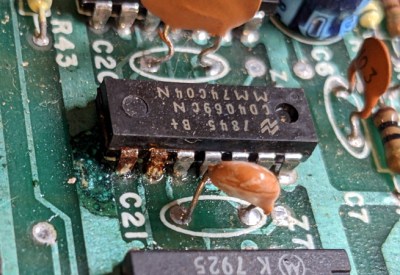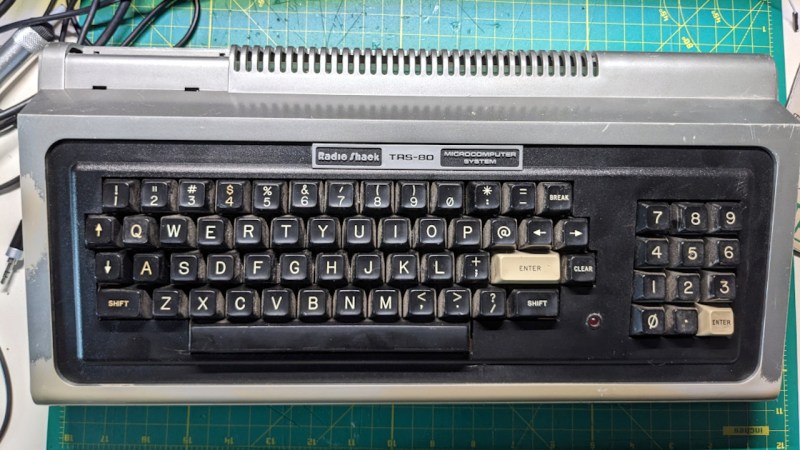We don’t know if you’ve looked into it recently, but the prices for vintage computers are through the roof right now. These classic machines are going through something of a renaissance at the moment, with even relatively commonplace computers commanding several hundred dollars if they’re in good condition. For those looking to start a collection without breaking the bank, you may need to accept some specimens that have seen better days.
That’s the situation [Vlado Vince] recently found himself in — he wanted to get his hands on a TRS-80 Model I, but wasn’t willing to spend eBay prices. So he waited until the Vintage Computer Federation’s swap meet in June and was able to snag a “fully functional” example for $95. Unfortunately the seller must have been using some form of that phrase which we were previously unaware of, as it took a considerable amount of work to get it back online.
 Getting the machine home [Vlado] was only able to get a very faint video signal out of it, and even then, it had no horizontal sync. Upon opening it up he found considerable corrosion, in addition to signs of previous repairs and bodges. Doing some research he found that one of the corroded ICs was indeed part of the video circuit, so it was carefully extracted and replaced with a socket to take the new chip. He also removed a hacked together memory upgrade that was likely installed in the 1980s, figuring it being there would only complicate the repair.
Getting the machine home [Vlado] was only able to get a very faint video signal out of it, and even then, it had no horizontal sync. Upon opening it up he found considerable corrosion, in addition to signs of previous repairs and bodges. Doing some research he found that one of the corroded ICs was indeed part of the video circuit, so it was carefully extracted and replaced with a socket to take the new chip. He also removed a hacked together memory upgrade that was likely installed in the 1980s, figuring it being there would only complicate the repair.
This still didn’t give him a useful video signal, so he started a closer examination of the board. It turns out there were subtle modifications all over the place, with traces cut and whole components removed for reasons unknown. With the board schematics in hand, [Vlado] started undoing the changes and returning the circuits to their stock arrangement. He also repaired the badly damaged keyboard connector, as the previous owner’s bodge wires didn’t seem to be up to the task. These efforts paid off as he was finally able to get the machine to boot, though the video was erratic.
At a loss for the continuing display problems, [Vlado] started replacing components in the video circuit hoping to luck out. He swapped out the electrolytic capacitors and variable resistors, and even tried replacing components in the power supply, but the issue remained.
He eventually got the oscilloscope out and started poking around the board, looking for anything that seemed out of the ordinary. He found that the signal coming from that very first video IC he replaced was out of spec; as it turned out he had replaced the original 74C04 with a 74LS04, but what he actually needed was a 74HC04. With the correct chip in place the image stabilized, and the machine was finally in the “fully functional” condition that he was promised in the first place.
Ultimately [Vlado] had set out to get his hands on a TRS-80 so he could get a better understanding of how it inspired Voja Antonić’s design of the Galaksija. Considering the amount of effort he put into this repair, we’re willing to bet he got all the insight he was looking for. Especially when combined with the experience of building his own Galaksija replica.
Incidentally, if you take a look at our video from the VCF swap meet, you can actually see the TRS-80 [Vlado] ended up buying at around the 0:50 mark. If you happen to have grabbed one of the other computers covered in that video and got it back up and running, we’d love to hear about it.


















Nostalgia is a powerful thing.
https://www.youtube.com/@RecollectionRoad
Freak
The TRS-80 Mod 1 was not my first computer to build and learn to program but it was the first one that I owned and it served me well for many years. I would not mind finding another one even in that condition and performing a restoration.
I meant to say not my first computer as I helped build other computers before buying my own TRS-80
Well done, Vlado!
Even after they stopped selling the Model 1, RS continued to do upgrades and fixes on it, so there were a lot of units with bunches of officially sanctioned bodge wires.
The “Level II” BASIC upgrade, for example, did not fit in the two available ROM sockets on the main board, so they’d install this daughter board with the L2 ROMs, and that had a ribbon cable to the original ROM socket, but also a slew of single wires to pick up power, ground, and addressing.
Also, the keyboard was notorious for having key bounce issues, and the were ‘white wire’ fixes for that as well.
Not sure if the 16K memory upgrade required bodges, but I want to say it did – I think the original 4K RAMs wanted three supply voltages but the 4116 devices didn’t. But enough ruminative speculation!
I expected to see 74Cxx problems and was quickly confirmed. A few months ago I brought down my very old Model I (stackpole keys, no keypad) and its video was all messed up, so it’s a future project to fix. I do have to giggle at someone not noticing that it’s CMOS and dropping a 74LS04 in its place. Using any chip starting with “74” like that can be quite the curve ball.
And as for little-known inspirations from TRS-80, there’s a “Pre-Computer 1000” which has a very binary-patched version of the Model III ROM. (itself binary patched from the Model I Level II ROM) I found my third one last week!
In 1992 my (now deceased) father was redoing his bathroom. He placed his fully functional coloco Adam computer, wrapped in plastic, in a void.
He was sure that some day it’s value would return.
Heh. The last time I looked at Model I prices on eBay, working models were under US$100, I think. At one point, maybe 20 years ago, I think they were going for $25-30. Guess I should go check again, not that I’d be looking to sell mine…
In the mid 90s I was finding a few “Trash-80” in the trash. I took them, they all worked fine. I sold them a few years later.
Along with the green monitors?
I think they’re the most valuable part of the TRS-80, next to the power cord. ;)
Unfortunately no, all got smashed. CRT don’t take kindly to being tossed into a dumpster.
Here in the US, the standard Model 1 monitor was the usual monochrome bluish-grey of a black-and-white TV — because that’s essentially what it was, minus the tuner and with some tweaks to the bandwidth.
“One of these days” I need to dust off my old model I (my first computer) and see if it still works. Thankfully I’m enough of a pack rat (hoarder) that I still have my old 8 bit machines and even acquired a few more when they were still considered trash rather than vintage treasures.
I still have two of the TRS-80 Model 1 computers. If I remember correctly, the first one I opened to upgrade the memory from 4k to 16k did not have a daughter board for the level II rom. I did buy that one around 1982, so they may have redesigned the main board since the original level II rom was added.
I don’t remember where I picked up the other Model 1.
Maybe when I finally retire I can take a look at them again. They shouldn’t require to much work to get them running again.
My first real computer was a TRS-80 Model I, although I’d previously built a Motorola D2 MC6800 kit.
I formed NATGUG, the National TRS-80 User’s Group, here in the UK. It’s still going!
NATGUG: https://trs-80.org.uk/
Please may I reproduce your post in the Sept. edition of TRS8BIT. (the newsletter from trs-80.org.uk)
Sure. As I recall I did a motherboard mod to swtch between favoring CPU or video . Swicth on side of kybd. Maybe it came from Steve Ciarcia’s Circuit Cellars!
I have a perfectly good/working TRS-80 Model I with display manuals external floppy drives (not Radio Shack) etc. that I would like to find a good home for.
Is anyone interested?